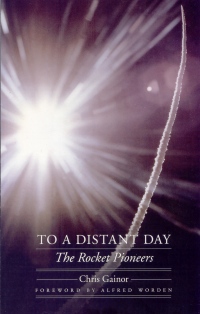| ________________
CM . . .
. Volume XX Number 4. . . .September 27, 2013
excerpt:
To a Distant Day is a history of rocketry and mankind’s fascination with space. In addition, it deals with the development of jet aircraft and the use of balloons to take man into the upper atmosphere. This well-researched book contains 11 chapters of roughly twenty pages each and is illustrated with many black and white photographs spread throughout the book. In addition to an index and an extensive list of sources, it also has a list of “Acronyms and Abbreviations” which helps in the understanding of the text. To a Distant Day could be used for recreational reading. Most of the book is a history of the contributions of rocket scientists whose work eventually resulted in manned space flight. Only the names of a few of these are likely known to readers. This history should help to rectify this problem because some of the scientists were most unusual characters. Hermann Oberth, for example, a German scientist who lived in what is now Romania, was a technical director for movie director Fritz Lang. Lang, Germany`s leading film director before the Second War, made the sci-fi movie Woman in the Moon which introduced viewers to rocket travel for the first time. Unfortunately, it did poorly because it was a silent film when talking pictures were already popular. There are many details in the book most likely unknown to most readers. Many, for example, may know about German scientist Wernher von Braun’s move to the United States after the Second World War and his contribution to the American rocket program, but they may not have heard about the forced removal of German scientists to the Soviet Union in 1946. In a similar way to von Braun's work, their efforts stimulated the Soviet rocket program. Several chapters stand out for their interest quotient. These include those on the Soviet achievements in rocketry and space travel and the German work on rockets for military purposes prior to and during World War II. The discussion of science fiction accounts of space travel is also very interesting. The best-known of these were the novels of French author Jules Verne whose popular books stimulated the interest in space. Verne included scientific facts in his stories which made them sound believable. To a Distant Day contains some amazing facts and legends. “The chemical composition of humans and other living things more closely resembles the stars than the earth” is one such fact. A popular legend concerns Chinese mandarin Wan Hu who may have been the first human to ride a rocket in the sixteenth century. He “is said to have disappeared in a cloud of smoke after assistants lit forty-seven rockets attached to his chair.” Interest in rockets could also lead to some strange ideas. One of the strangest was the 1930's “Hollow Earth Doctrine”. According to this theory, the universe was only an illusion and that a rocket fired from the west would only reach Australia or New Zealand because the earth was a hollow sphere. Chris Gainor, author of To a Distant Day, has written five books, including four on the history of space exploration. He has a Ph.D in the history of technology and is a specialist in aeronautics and space exploration. Recommended. Thomas F. Chambers, an author and retired college teacher, lives in North Bay, ON.
To comment
on this title or this review, send mail to cm@umanitoba.ca.
Copyright © the Manitoba Library Association. Reproduction for personal
use is permitted only if this copyright notice is maintained. Any
other reproduction is prohibited without permission.
NEXT REVIEW | TABLE OF CONTENTS FOR THIS ISSUE
- September 27 2013.
AUTHORS |
TITLES |
MEDIA REVIEWS |
PROFILES |
BACK ISSUES |
SEARCH |
CMARCHIVE |
HOME |
